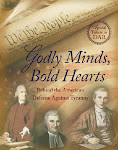Samuel Parris was a merchant who also served as a pastor in the town of Salem, Massachusetts, a growing town which was undergoing the stress of rapid economic and political transitions.
Upon his return to his home in Massachusetts from a business trip in Barbados, he brought back two slaves. One of these slaves, Tituba, was designated by him to take care of his nine-year-old daughter Elizabeth and his eleven-year-old niece Abigail.
Parris allowed the girls virtually no entertainment, and so they found the stories of Tituba quite fascinating as she told them about the voodoo practices of her native island. The girls told some of their village friends, including Ann Putnam; and all of them started playing with the voodoo Tituba described. They even began to engage in fortune-telling.
Then in January 1692, Elizabeth (Betty) and Abigail started having mysterious fits. During a church service Betty screamed, and she started writhing on the floor. Then the other girls fell to the floor and started having similar types of fits while making strange, sometimes animal-like noises.
A doctor became convinced their pain was caused by witchcraft. As belief in witchcraft was not uncommon throughout the 17th century America and Europe, the townspeople became alarmed. They begged the girls to tell them who was causing the torture.
The young girls finally thought of three names to cry out: Tituba the slave, Sarah Good--a homeless woman, and Sarah Osborn--a sickly old woman who had married her servant. These women were arrested and moved to the Boston prison where Sarah Osborn died.
Thus, a tragic chain of events in public hysteria had begun.
Samuel Parris called in more authorities to determine if the girls' affliction was indeed caused by witchcraft. Although Betty was sent away and did not participate in the trials, the other girls were coached by women to stage public demonstrations of their affiction when in the presence of 'witches.'
Both Sarah Good and Sarah Osborn before her death had held to their innocence, but Tituba confessed of being a witch after a beating by her master Parris. She said she had been ordered by a black dog to hurt the girls and that she could ride through the air on a pole to attend the witch's meetings. She further told the magistrate that there were other witches in Salem led by a tall man who had a white beard. With Tituba's story of there being other witches, pressure was placed on the girls to give out more names of witches in their midst.
Ann Putnam, directed by her mother, pointed at Martha Corey, a member of the Salem Village congregation. During her trial, Martha maintained her innocence but the girls in attendance cried out in fits of supposed torment and anguish. Believing the girls, her own husband testified against her.
Rebecca Nurse, a prominent member of the church and also a grandmother to four-year-old Dorcus Good, was accused directly by Ann Putman's mother. Rebecca's family had been involved in disputes with the powerful Putnam family. Before she was executed, she was heard to say, "Oh Lord, help me! It is false. I am clear. For my life now lies in your hands...." Shortly after Rebecca died, the small child Dorcus was accused as well and would spend months chained to a wall in the town jail.
The court allowed testimony against accused witches that they were seen at night as spirits or in a personal vision. Though such accusations could in no way be verified or be converted into common sense, victims lost their lives.
Local tavern owners John and Elizabeth Proctor had been vocal about their opposition to the trials; they were soon accused of being witches themselves. Rebecca Nurse's sister Sara Cloyse was also accused. While these three awaited trial, arrests were made of Mary Warren, Bridget Bishop, and Abigail Hobbs.
Giles Corey was also arrested but refused to stand trial. He was pressed to death under a pile of rocks.
Abigail Hobbs was known to be mentally unwell but the magistrates still accepted that she was a witch, and they believed her accusations against Nehemiah Abbot, William and Deliverence Hobbs, Sarah and Edward Bishop, Mary Ester, Mary Black, Sarah Wilds, and Mary English. These nine were arrested in April. Accusations against Nehemiah Abbot were later dropped.
The psychological madness began to include people who were not familiar with any of Salem's local grudges; and the accusations continued to grow into a powerful force of Salem until they finally reached the wife of a new Governor from England, Sir William Phips. With this blow, suspicions began to rise about whether or not the accusations were genuine.
Increase Mather (father of Cotton who wrote, 'If a Drop of Innocent Blood should be shed, in the Prosecution of the Witchcrafts among us, how unhappy are we!) forcefully argued that it would be better that ten witches go free than the blood of a single innocent be shed. The other ministers took a strong stand; and the trials were halted. Those still in jail were later acquitted or given reprieves. Almost as fast as it had started, the witch hunt ended.
In all, nineteen people were hanged at Gallows Hill, one pressed to death, and four others died in prison awaiting trial Many of those accused had lost their property, their money, and retained the stigma of being a witch for the rest of their lvies.
Ann Putmam was the only one of the girls to publicly stand in front of the Salem congregation to apologize. She said it was a great delusion of Satan that made her act as badly as she did.
----------------------------------
Cotton Mather was a scholar who struggled through and tried to explain the superstitions of his time.
Excelling in his entrance exams in Latin and Greek, he began Harvard at only 12 years of age. After receiving his M.A. at age 18, he wished to become a pastor but delayed because of a terrible stutter. He turned his mind to medicine and is recognized as having been a progressive medical advocate for his day.
Before the outbreak of accusations in Salem Village, Mather had already published his account, Remarkable Providences (1684), outlining clinical symptoms of being possessed. He actually took a child into his home to make a more intense study of the phenomenon. Later scholars have suggested that his book described the symptoms of clinical hysteria. His publication, Curiosa Americana, proved him an accomplished scientist and earned him election to the prestigious Royal Society of London, England.
"Although Mather was not directly involved in the proceedings of the Salem witch trials, he wrote a letter to one of the magistrates in the trials urging caution in the use of spectral evidence. Mather was also the author of the "Return of the Several Ministers," a report sent to the judges of the Salem court. This document advised caution in the use of spectral evidence, saying that the devil could assume the shape of an innocent person. However, the final paragraph of the document appears to undercut this cautionary statement in recommending "the detection of witchcrafts". Thus the courts interpreted the letter as Mather's seal of approval for the trials to go on." Source
----------------------------------
On the brighter side: Halloween Poem, click here.























































































